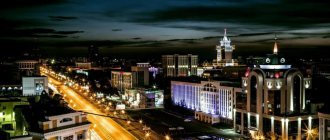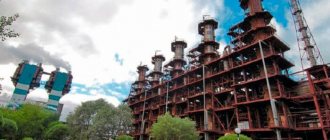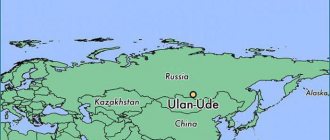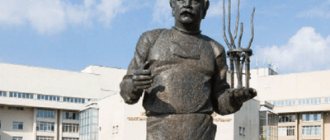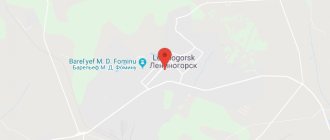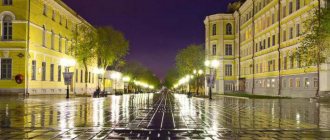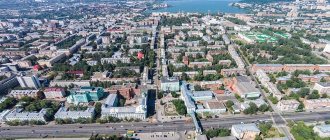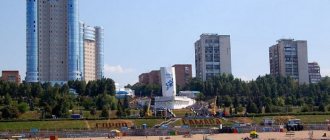Ulyanovsk is known primarily for the fact that V. Lenin was born here. But this ancient Russian city can rightfully be proud of many other events in its history. The indigenous population of Ulyanovsk can tell a lot about the sights and famous residents of the city. This large economic center of the Volga region is similar to many Russian cities, but still has its own face and characteristics. Let's talk about the population of Ulyanovsk, how the demographic and economic situation differs in this regional center.
Geographical position
The city is located on the banks of two rivers, the Volga and Sviyaga. Ulyanovsk is separated from the capital of our homeland by almost 900 km. The settlement is located on a hilly area; the population of Ulyanovsk initially preferred the more hilly right-bank part, where the elevation changes are up to 60 meters. The left bank is flatter, but less populated. Ulyanovsk is located in the center of the European part of Russia, on the Volga Upland. On average, the city lies at an altitude of 80-160 meters above sea level. Ulyanovsk is surrounded on all sides by deciduous forests. The strategically favorable location on the routes from the European to the Asian part of the country allowed the city to develop steadily over several centuries. Today the area of Ulyanovsk is about 320 square meters. km.
Hymn
In the land where the great Volga Flows freely along the Crown, Simbirsk has established itself for a long time By the will of the creator people! Our ancestors lovingly raised this bright and valiant land... Ulyanovsk! For the glory of Russia, create and prosper for centuries!!!
The city spreads out like a bird, in the expanse of river banks: Be proud, regional capital, of the deeds of your fellow countrymen! From the shining blue of Trans-Volga into the distance of Trans-Volga grow... Ulyanovsk! For the glory of Russia, create and prosper for centuries!!!
Your melodies are majestic, your traditions are strong in faith, always be the engine of the power and the wings of a glorious country! Develop, subduing the elements, Find stars of new victories... Ulyanovsk! For the glory of Russia, create and prosper for centuries!!! Ulyanovsk! For the glory of Russia, create and prosper for centuries!!!
Words by N. Maryanin, music by S. Lyamin.
Approved on June 9, 2008.
City `s history
A settlement on the banks of the Volga appeared in 1648 by decree of Tsar Alexei Mikhailovich. A fortress was created here to defend the borders of the state from invaders. The city successfully withstood the defense from the army of Stepan Razin, for which it received a coat of arms. Here in 1774, Alexander Suvorov personally interrogated Emelyan Pugachev. In 1780, Simbirsk became a provincial town. In 1864, a terrible fire destroyed three quarters of the city, and its “new” history began. In 1870, the future leader of the proletariat V. Ulyanov was born in the city. In 1898, a railway was built to Simbirsk, which contributed to its growth and development. In 1924 it was renamed Ulyanovsk. During World War II, many enterprises from Moscow were evacuated here. After the war, the city became a major industrial and scientific center of the Volga region.
Ulyanovsk
History of Ulyanovsk
The founding of Ulyanovsk dates back to a written decree of Tsar Alexei Mikhailovich dated February 10, 1648, by which the autocrat ordered one of his military leaders, Bogdan Khitrovo, to go to the lower reaches of the Volga to protect the southeastern borders of the state from nomadic raids and build new settlements there.
So one order laid the foundation for a number of cities. The city of Sinbirsk, as it was called then, became one of the first fortifications of the abatis line in this area. The fortress was built approximately in the place where, according to the map of the German historian and geographer Adam Olearius, already in the time of Tamerlane (XIV century) there was a settlement called “Sinbir” or “Sinbir Mountain”. Whether there was a settlement here, presumably founded either by the Bulgars or the Horde, is not known for sure, as is the origin of the name of the city. Historians, Ulyanovsk local historians and even representatives of local authorities are actively putting forward new hypotheses about this, but the only reliable fact is that the city was called Sinbirsk until 1780, then the name was transformed into “Simbirsk”. As for the Simbirsk Mountain itself, the hill on which the Kremlin was built, archaeologists have discovered here the remains of settlements, burials, as well as artifacts dating back to the period from the early Bulgars to the Kazan Khanate.
By 1652, 5 years after the founding of the “zasechny” village, Sinbirsk already had all the proper attributes of a fortified center corresponding to that time: a fortress wall with towers and a moat surrounding the voivode’s courtyard with an official hut and a church. A convent was built near the western wall. The elite lived in the Kremlin - the governor with the boyars, service people, and to the southeast of the walls a settlement was formed, inhabited by artisans, craftsmen, and traders.
The fortress survived its first siege in 1670, when it was unsuccessfully attacked by the troops of Stepan Razin; a year later it was stormed by the closest associate of the leader of the Cossack uprising, Fyodor Sheludyak. Sinbirsk survived this time too, for which Tsar Alexei Mikhailovich granted him the first coat of arms. In 1708, during the reforms of Peter I, Sinbirsky district was included in the Kazan province, and already in 1711 it was transformed into the Sinbirsky province. The emperor himself visited here in 1722. Catherine II also visited Sinbirsk. The Empress arrived here in 1767, and 7 years later, on her orders, the captured rebel Emelyan Pugachev was brought to the local prison in an iron cage. Here he was tried and then sent to Moscow.
In the 18th century, as the borders of the Russian Empire moved east, Simbirsk lost its strategic importance, but successfully developed as a regional center. In 1780 it received the status of a provincial town. In subsequent years, it was considered a not very rich city, but prosperous. In the 19th century and until the revolution, the famous National Assembly Fair, one of the largest in the Volga region, was held here, and one of the first serf theaters in the Russian Empire was opened. In Simbirsk there was a theological seminary and gymnasium, in one of which Vladimir Ulyanov, the future founder of the Soviet state, studied with excellent marks. In 1924, after his death, Simbirsk was renamed Ulyanovsk. Periodically emerging initiatives to return the city's historical name have not yet been successful. It is worth saying that other famous people were natives of Simbirsk, for example, the writer Ivan Goncharov, the poet-hussar, the hero of the war with Napoleon Denis Davydov, and the politician Alexander Kerensky.
Until the start of the Great Patriotic War, Ulyanovsk was a rather ordinary provincial city, home to about 110,000 people. Its industrial development began in the 60s, when factories were built here, a port for cargo ships, and a river station receiving passenger ships were built. In 1976, in Ulyanovsk, on the left bank of the Volga, construction began on an aviation-industrial complex - the largest in the USSR. The 90s brought the city a decline in production in all sectors, mass unemployment, and a crisis in infrastructure. Ulyanovsk began to recover only in recent decades.
Geography and climate
Ulyanovsk covers an area of 316 km². The city is located in the center of the European part of Russia, on the banks of the Volga and Sviyaga, in the forest-steppe zone. The Great Russian River divides Ulyanovsk into two parts - the left bank and the right bank. They are connected by two bridges, which are called “Imperial” and “Presidential”. Left-bank Ulyanovsk belongs to the low-lying Trans-Volga region, and the historical part of the city, on the right bank, is located on the Volga Upland. In turn, the right-bank Zasviyazhsky district is located in a lowland, it has its own microclimate: the air warms up well and stagnates, in this part of the city it is always a little warmer than in other areas. Ulyanovsk is surrounded by hilly steppes, the topography of city streets is also hilly, the elevation changes reach 60 meters.
It is curious that within the city limits the Volga and its tributary Sviyaga flow in opposite directions. In Ulyanovsk, the distance between these rivers is about 2 km. The Sviyaga flows into the Volga in the waters of the Kuibyshev Reservoir, the largest in Eurasia. Its construction led to the flooding of large areas of land north and south of Ulyanovsk. Just above the city, the width of the water surface of the man-made reservoir is 27 km.
Ulyanovsk is constantly blown by the wind from the Volga, thanks to which the city air is always pleasantly refreshing. True, in inclement weather gusts of wind can be quite powerful. But, in general, the temperate continental climate characteristic of Ulyanovsk is quite comfortable and delights its residents with both sunny summers and real Russian winters. Snow cover in the city forms by the end of November and remains until mid-April. The coldest month here is January, when the air temperature usually varies between -15...-6 °C.
In March it is still frosty; spring only announces itself in April. By the middle of this month, daytime temperatures are already above the 10-degree mark. By the end of May there is about +20 °C during the daytime and +16…+18 °C at night. By this time, the water in the Volga is already warming up to +19…+21 °C. From June to the third ten days of August it is warm in Ulyanovsk: during the day +23...+27 °C, at night +20...+23 °C. The water temperature can be +25…+27 °C. By the end of August, the thermometer drops to +20 °C during the daytime, and it gradually begins to get colder. From mid to late September the temperature drops from +16 °C to +10 °C. In October, frosts are common at night, and from mid-November frosty weather sets in in the city.
The rainiest months in Ulyanovsk are July and September, with the least precipitation falling from February to April.
Sights of Ulyanovsk
Many historical buildings have been preserved in Ulyanovsk, giving the central blocks a unique aura of antiquity. Bronze plaques on the walls of charming mansions tell who these buildings were built for and when. You will not pass by the apartment building of the merchant Levashov on Karl Marx Street, 7, the architectural appearance of which resembles a real palace. By the way, before the revolution this street was called Dvortsovaya, the city elite settled here (not so long ago, parts of the street named after Karl Marx returned their old name). The rich man Levashov, who held the post of merchant elder of Simbirsk at the end of the 19th and beginning of the 20th centuries, was known as a generous philanthropist. In 1911, the Express cinema was opened in this building; it operated until the 40s of the last century.
The streets of the Old Town are also decorated with buildings built in the Art Nouveau style, fashionable at the beginning of the 20th century. In one of them, which belonged to Baron von Bradke, there is a museum called “Art Nouveau Architecture in Simbirsk” (Lva Tolstoy St., 43). You can view the interesting exhibition every day, except Mondays, from 09:00 to 17:00.
On Cathedral Square, which until recently bore the name of Lenin, near the facade of the Philharmonic building, the attention of tourists is attracted by the original wind organ. When the wind blows, its pipes emit melodious sounds. This 8-meter musical monument was installed here in 2006, when the city held the Singing Metal blacksmithing festival.
In the very center of Ulyanovsk, the unique museum-reserve “Motherland of V.I. Lenin” occupies more than 170 hectares. It includes several restored ancient quarters, recreating the atmosphere of provincial Simbirsk in the 70s of the 19th century. Small museum exhibitions housed in historical buildings and colorful sculptural compositions help you get into the spirit of the city in which the future leader of the world revolution was born and raised. Museums of postal services, public education, and merchants have been created here. There is a bronze figure of a policeman at the fire department museum, and a chimney sweep boy sits on the fence. Here, in the fire station building built in 1874, with a high tower, stables and other services, there is a historical exhibition telling about fire protection in pre-revolutionary Simbirsk. Interesting exhibits are displayed in the windows of the archaeological museum, in the ancient weather station, carpentry workshop, and trading shop.
The entrance ticket to the reserve costs 100 rubles, children under 16 years old enter free of charge. Inspection of the house-museum of V.I. Lenin’s family as part of an excursion – 200 rubles. A walking tour accompanied by a guide and a detailed story about all the mini-museums of the reserve will cost 600 rubles.
It is interesting to plunge into the atmosphere of the old estate on Lenin Street, 90. The house belonged to the priest of the Trinity Cathedral, and in 1876-1877 it was rented by the Ulyanov family. Household items of that time, books and newspapers are collected here, the rooms are furnished with antique furniture.
In the old estate on Engelsa Street, 1-A, the Simbirsk Photography Museum is located. Its exhibition was selected with great artistic taste. In the authentic photographic pavilion of the early 20th century, you can try on the clothes of the townspeople of the first decade of the last century and conduct a photo shoot. The museum's wardrobe includes festive outfits for children, crinoline dresses and hats for ladies, frock coats, canes, bowlers and top hats for gentlemen. The cost of renting an outfit is up to 150 rubles.
The square on Tchaikovsky Street is decorated with a monument to the outstanding native of the Simbirsk province, historian and writer Nikolai Mikhailovich Karamzin, author of the story “Poor Liza” and other works. Karamzin became famous for his main work - the multi-volume History of the Russian State. The scientist used ancient chronicles and documents, many of which were subsequently lost. This gives his work special value. In memory of Karamzin, an allegorical monument made in the style of classicism was erected in 1845. The granite pedestal is crowned with a bronze statue of the muse of history, Clio, and a bust of Karamzin is placed in a niche on the pedestal. There are also cast high reliefs with thematic images. According to the classical tradition, all the characters in the high reliefs are dressed in Roman togas.
There are also funny monuments in the city. On Novy Venets Boulevard there is a monument to the letter “Y”, which is also associated with the name of Karamzin. As researchers have found out, it replenished the Russian alphabet in 1797 and was first used in one of the publications of the literary almanac “Aonida”, published by Nikolai Karamzin.
Another “literary” monument was installed in the park on Goncharova Street. Here in 2005 a sofa of the lazy landowner Oblomov appeared, covered with imitation brocade with gold embossing. They say that this plastic covering gets so hot in the summer heat that it is impossible to sit on the sofa for a long time, but a few moments are enough for a memorable photo. By the sofa stand the bronze slippers of the famous sad lazy man and dreamer, and on the music stand lies an open book - the novel “Oblomov”. Nearby there is a monument to the writer Ivan Aleksandrovich Goncharov, who was born in Simbirsk, the author of this work.
On weekends, artists gather in the park to sell their paintings. Opposite is the Goncharov Historical and Memorial Museum. You can view the exhibition on weekdays from 10:00 to 18:00, Saturday and Sunday are days off. The entrance ticket costs 100 rubles. The ancient museum building, built of red brick with elegant snow-white decorative elements, is crowned with a clock turret.
Ulyanovsk has a unique collection of flying machines created over the last century in Russia. The Museum of the History of Civil Aviation is located near the Ulyanovsk airport, on Mozhaiskogo Street, 8/8, in the village of Barataevka. Domestic planes and helicopters lined up on a vast area of 18 hectares. The true patriarch here is the ANT-4 heavy bomber, built in 1925. This is the only surviving copy of the legendary aircraft designer Tupolev. Such a twin-engine all-metal monoplane at one time became the owner of a number of world records, and in 1929 it made an intercontinental flight, unprecedented at that time, from Russia to America.
At the memorial airfield, both propeller-driven aircraft of past years and modern turbojet giants that have exhausted their flight life are frozen. The world's first supersonic passenger airliner Tu-144 enjoys special attention from tourists. You can visit his salon on a special tour. Interestingly, this aircraft is still operational and capable of taking to the skies.
From the city center you can get to the Aviation Museum by minibus No. 91. Plan for at least one and a half to two hours for this walk. The exhibition is open from 10:00 to 17:00. The cost of an entrance ticket is 120 rubles, a child ticket is 60 rubles. For photo and video shooting you need to pay an additional 50 rubles. Some helicopters and airplanes can be viewed from the inside, sitting at the helm in the pilot's seat. There is no place to eat on the territory of the Aviation Museum, so it is worth bringing snacks and water with you.
Beaches
Ulyanovsk has several beaches located on the banks of the Volga and lakes. The most popular and crowded is the Central City Beach. There are “fungi” installed here, there are changing cabins, and a sun lounger rental station (50 rubles per day). There are cafes and kiosks with inexpensive fast food on the beach. There are grounds for volleyball and beach soccer. There is a spacious strip of sand along the shore, the entrance to the water is gentle. Minibuses No. 2, 7, 22, 25, 70, 82, 112 will take you to the beach.
The paid beach is located on a pond in the beautifully maintained Alexander Park. This is a wonderful place to relax; the park alleys are decorated with sculptures, fountains, gazebos, there are summer cafes, a restaurant and a water park. The beach near the pond here is small, but well equipped - there are playgrounds and slides. The cost of visiting is 150 rubles. Umbrellas and sun loungers are available for rent (100 rubles per day), you can rent a double catamaran and swim on the lake (200 rubles for 30 minutes). Smoking and drinking alcohol near the water is prohibited. The park beach is open from 08:00 to 24:00.
On Leninsky Gorki there is a paid beach area “Oasis”. It's perfectly clean here. The sandy coast has decent infrastructure. You can play volleyball, do fitness, jump on a trampoline, rent a boat or pedal boat. There is a swimming pool built on the hill, sun loungers installed, and a water park and cafe nearby. From here a beautiful panorama of the Volga opens. The beach area is open from 10:00 to 20:00. Entrance fee for adults is 200 rubles, for teenagers 8-14 years old - 100 rubles.
Residents of the Volga region use the beach in the coastal park named after. 40th anniversary of the Komsomol. There are changing cabins, a toilet, and a cafe. There is a spacious sandy beach on the Volga bank in the suburban Fisherman's village. The river flow here is moderate, but the bottom goes to a depth already two steps from the shore. There is a barbecue and toilet on the beach. There are few sun loungers here, and the rental point is often closed. Route taxi No. 77 goes here.
In the area of the river port there are small sandy islands, densely covered with trees and bushes. If you have a boat, you can have a picnic there and swim all alone.
Entertainment in Ulyanovsk
In Ulyanovsk it is worth visiting the drama theater. It is located on Sovetskaya Street, 12-A, not far from the Lenin Memorial. The theater building was erected in 1879. The repertoire includes works by Russian and foreign classical playwrights. Thematic festivals are also held here - “Goncharov’s Heroes on Stage”, “History of the Russian State”. Every year, as part of the Litsedey festival, theater troupes from other Russian cities give performances on the Ulyanovsk stage.
To have fun with your children, go to the Ulyanovsk Puppet Theater. It is located in a historical building on Goncharova Street, 10. By the way, the theater directors have created productions for adult viewers. Children will also enjoy the small interactive Museum of Entertaining Sciences, located in an old wooden house on Lenina Street, 17. The exhibits presented here can be touched and disassembled; the staff organizes spectacular physical experiments and educational excursions. The entrance ticket costs 300 rubles.
Adventure towns "Adrenaline" are located in Victory Park and in the park named after. 40th anniversary of the Komsomol. There are rope labyrinths in the trees, four levels of bridge height and difficulty of passage. On the way there are “chasms” that need to be dashed across on a bungee rope. Visitors are provided with equipment, and the ropeways are supervised by instructors. A full ticket to complete all the labyrinths will cost 600 rubles. There is also a contact mini-zoo where kids, lambs, rabbits and birds live: turkeys, roosters, pheasants. Entrance – 30 rubles, bag of animal food – 20 rubles. Both Adrenaline parks are open from 08:00 to 20:00.
On Olimpiysky Prospekt, 6-A, there is a huge karting center, one of the largest in Russia. The area of the indoor racing area is 5000 m², the center also has an outdoor track with a length of almost 1.5 km. There are cars for adults and children to choose from. The cost of a 10-minute race is 400 rubles; for children’s karting you need to pay 300 rubles. Instruction for beginners – 500 rubles. The center is open from 12:00 to 23:00.
Several trampoline parks are open in Ulyanovsk. One of them is located on Pervomaiskaya Street, 44. Tickets cost 150 rubles per person per half hour, a ticket for two will cost 400 rubles per hour. On the third floor of the shopping mall, on Ryabikova Street, 70, the Kangaroo trampoline park is open daily from 10:00 to 21:00. You will find another popular trampoline room called “Vverkh” on Oktyabrskaya Street, 22-A. An hour on the trampolines costs 300 rubles. In addition, there are electric cars for children and you can play air hockey.
In 2015, the indoor water park “Ulet” was built in the Alexander Garden. There are seven slides and three pools. Some of the slides are located outside; in winter they do not function. The building has a cafe and a bath complex - a Turkish hammam, Roman baths, and a Finnish sauna. On weekdays, the cost of a two-hour visit to the water park for adults is 370 rubles, for children 5-12 years old – 300 rubles. An unlimited ticket can be purchased for 650 and 500 rubles, respectively. On weekends, unlimited access for adults is offered for 900 rubles, for children – for 700 rubles. Water activities in the water park are available daily from 10:00 to 21:00, closed on Mondays.
The paintball club "Bastion" is located on Yunosti Street, 2. "Battles" take place in a fenced area in the nearby Victory Park. The cost of participation in the game is from 450 to 900 rubles, depending on the duration and equipment. The club is open all year round. Trams No. 1 and 4 and minibuses go to Victory Park.
In winter, on the banks of the Volga within the boundaries of Ulyanovsk (Stepan Razin Descent, 33), lovers of active recreation will find the Lenin Hills ski park. There are slopes for skiers and snowboarders here.
Purchases
Ulyanovsk has modern shopping centers, the largest of which is the Aquamall shopping center, located in the Zasviyazhsky district, on Moskovskoe highway, 108, right on the picturesque bank of the Sviyaga River. In addition to a huge number of shops, there is a play area for children and a cinema. There is a huge Ferris wheel installed in front of the Aquamall. A 10-minute walk from this shopping center is an old shopping center, which began to empty after the appearance of a “heavyweight competitor”. In the central blocks there are the shopping centers “Spartak” (Minaeva St., 11) and “Versailles” (Dvortsovaya St., 4-A/1). In the New City, on Ulyanovsky Prospekt, 1, the Samolet shopping center was built.
For souvenirs, guests of Ulyanovsk usually go to the Central Department Store, located on Goncharova Street, 21, or to the “Simbirsk Souvenir” located a few steps away. The branch of this store is located on Leninsky Komsomol Avenue, 45. Opposite the Central Department Store there is another souvenir store - “Dryad”.
The most common souvenir products are associated with the name of Lenin. Everywhere you can buy products with Soviet symbols and, of course, badges, postcards, figurines, busts of the leader of the world proletariat, where he is depicted in different years of his life. Fans of Ilyich can go for similar items to the memorial museum that bears his name - there they have the widest choice.
In Ulyanovsk souvenir shops you can also buy aviation-themed souvenirs - airplane models, construction kits, dishes with appropriate prints. Products marked with the letter “Y” are popular among tourists – magnets, key rings, mugs. As a gift for children, buy a soft toy or figurine with the image of the cheerful fidget Kolobok, a gift edition of a fairy tale about this hero. The oscillator, as it is often called here, decorates wooden spoons, piggy banks and other trinkets.
An excellent purchase as a souvenir of Ulyanovsk would be a product made of symbircite, a close “relative” of onyx. Its deposit was discovered north of the city in 1765. The ornamental stone is named after Simbirsk. Geologists claim that such a rare mineral is found only in the Volga region, along the banks of the Oka in the neighboring Nizhny Novgorod region, and also in Argentina. In Ulyanovsk, on Spasskaya Street, near the Venets Hotel, a monument to a local gem was erected in 2005. The composition is made in the form of a fossil ammonite mollusk shell, inlaid with polished simbircite plates.
Women will surely love beads, earrings, pendants, and bracelets with this wonderful translucent golden-honey colored stone. For such products, you should go to the Simbirtsit stone museum-salon (Marata St., 25), where you can purchase handmade products. In addition to jewelry, collectible simbircite nuggets of various sizes, mantel clocks, icons inlaid with this stone, and exquisite interior items are offered here. You can also find products made from simbircite in one of the stores of the Simbirsk Nugget chain. The cost of a key ring with a simbircite pendant is 350-400 rubles, prices for pendants in a cupronickel silver frame are 1300-2100 rubles. A stone box will cost 5000-6000 rubles. Original decorative compositions can cost much more.
Tourists also bring delicious gifts from Ulyanovsk. Souvenir shops and retail outlets with the Ulyanovskkhlebprom logo sell wonderful profitable gingerbread cookies in eye-catching packaging. At the market, pay attention to the local delicacy - dried roach, and for delicious smoked mackerel, salted herring, and dried bream, go to the Kaleidoscope farm store, located in the Zasviyazhsky district, on Ablukova Street, 39.
Restaurants and cafes
The most popular culinary establishments in Ulyanovsk are located on Goncharova, Dvortsovaya, Minaev streets, and in Molochny Lane. On Goncharova, 13, there is a nice restaurant with Georgian cuisine, “Mezzanine,” where two people can have a hearty lunch for 1,000 rubles (without alcohol). The signature dish here is khinkali; they also serve excellent lamb, several types of khachapuri, fresh salads, homemade lemonade, and good Georgian wines. A stone's throw from this restaurant is Traveler's Coffee, where, according to many visitors, they prepare the best breakfasts in the city and serve them with aromatic coffee. On Goncharova, 30, there is a popular pizzeria “Dodo Pizza”. You can taste pizza here from 245 rubles, excellent rolls with lingonberries will cost 165 rubles, cheesecakes – from 120 rubles. Nearby there is another pizzeria - Milano. Relatively expensive establishments on Goncharova Street include the Prego cafe with Italian cuisine. Here the average bill for two will be 1,500 rubles.
The coffee shops of the Coffee Bean chain are very popular among citizens and tourists. They are located on Minaev, Dvortsovaya, and Moskovskoe highway streets. A business lunch can be purchased here for 300 rubles. On Dvortsovaya Street, 6-A, there is a wonderful Cafeletto establishment, decorated in Provence style. The chefs specialize in French cuisine. Cafeletto occupies the first floor of the building, and on the second floor there is a stylish Noblesse restaurant, its menu features Mediterranean gastronomy. The restaurant is considered expensive; a hearty meal here will cost from 3,000 rubles for two. On the third floor there is a trendy lunch bar called Polden, where prices are also higher than the city average.
Prestigious restaurants in Ulyanovsk include “Oblomov” with Russian and European cuisine (Spasskaya St., 19/9), “Veprevo Kleno” (Federation St., 11), specializing in Czech cuisine, served accompanied by excellent Czech beer, “ Noble estate" (Lenina St., 69), "Spinach" with original cuisine (Kirova St., 79).
Where to stay
Most hotels in Ulyanovsk correspond to categories 2-3*, but there are also four-star hotels here. In 2015, the Hilton Garden Inn 4* hotel opened its doors. It is located in the very center of the city, on Goncharova Street, 25. This elegant six-story building houses 175 spacious rooms, a fitness center, a restaurant with a wide selection of dishes, and underground parking. Daily accommodation here will cost 3200-5400 rubles per room.
Away from the center, in the Zheleznodorozhny district (Aleksandrovskaya St., 60), the park-hotel “Imperial Club Deluxe” 4* is located. On its beautiful, well-groomed territory there is a swimming pool with a waterfall, a geyser and a “river”, a sauna, a gym, a spa center, a restaurant with home cooking, and a bar. The rooms here are bright and spacious, some of them are designed for people with disabilities. You can stay here by paying 4000-5630 rubles per day.
Guests of Ulyanovsk who went here on a business trip speak well of the modern 3*+ hotel “Rakurs” on Kirova Street, 79, a 5-minute drive from the Imperial Bridge. Its cozy small rooms are simply and elegantly decorated, Wi-Fi works without interruptions, and the hotel staff is professional and friendly. The cost of daily accommodation is 2365-3132 rubles. For business people, the nice new Ibis hotel located in the New Town is also suitable. Here you can rent a room for 2300-3500 rubles.
The three-star high-rise hotel “Venets”, built in the Soviet era and considered not so long ago the best in the city, remains popular. The spirit of a bygone era reigns within its walls, and most of the rooms are clearly in need of renovation. The undeniable advantages of this hotel include the opportunity to admire the magnificent panoramas opening from the windows of the rooms located on the upper floors facing the Volga. Accommodation price range: 1665-3000 rubles.
From 1,500 rubles per day you can stay in the modern 3* Grand Hotel (Tyuleneva St., 3-A). The prices are approximately the same in the 3* Oktyabrskaya hotel built in Soviet times (Plekhanova St., 1), in the mini-hotels “Cleopatra” (Lokomotivnaya St., 51), “Abazhur” (Yunosti St., 37).
There are also hostels in Ulyanovsk. In the center, on Federation Street, 7, there is the youth-oriented Orange hostel. For a bed in a shared 6-10-bed room here you will need to pay 500 rubles per day. You can rent a double room with two separate beds and a shared bathroom for 1,500 rubles. In the Zheleznodorozhny district, on Kirova Street, 6, on the ground floor of a high-rise building, SV-Hostel is located. Here the cost of an overnight stay in a dormitory room starts from 450 rubles per person.
Booking.com
Transport
Residents of Ulyanovsk have the opportunity to travel around the city by buses, trolleybuses, trams, and minibuses. A local feature is the “divergence” of routes along which electric transport runs. Trams serve only the right bank areas, and trolleybuses serve the left bank areas. The fare for trolleybuses and trams is 17 rubles (2019).
Buses run on 15 routes, five of which connect areas located on both banks of the Volga. This type of transport is not very popular among citizens, since only 4 routes are served seven days a week and throughout the day. But in some cases, buses are an indispensable form of public transport, because only with their help can you get to outlying areas and cross bridges where electric vehicles cannot travel.
The most important transport hub of the Ulyanovsk region is the Central Bus Station, which is located in the Zasviyazhsky district. Every day, about 400 buses depart from here to nearby villages and distant cities. The most popular destinations are Samara, Kazan, Nizhny Novgorod, Saratov, Togliatti. You can also travel to a number of nearby settlements from the “New City” bus station, which is located in the area of the same name, on Ulyanovsky Prospekt.
How to get there
Ulyanovsk has two international airports. Most flights are served by Barataevka Airport, located 9 km from the city center. Airliners and Pobeda fly here daily from Moscow Sheremetyevo and Vnukovo airports. The air carrier RusLine operates flights from Monday to Thursday. The flight lasts 1 hour 35 minutes.
You can get to Ulyanovsk without transfers from St. Petersburg by air on Tuesdays and Thursdays. You will spend 2 hours 10 minutes on the way. You can fly with a transfer in Moscow or Nizhny Novgorod - this opportunity is provided daily. Ulyanovsk is also connected to Sochi by direct flights. Airplanes depart for the Black Sea resort on Tuesdays and Fridays. The flight takes 2 hours 25 minutes.
You can get from the arrival terminal to the city center in about half an hour by minibuses No. 12, 66, 91, 116, 123, 156.
Vostochny Airport is located on the left bank of the Volga, 28 km from the center, not far from the aircraft plant. It mainly accepts charter cargo and passenger flights. Air planes fly here from Moscow 4 times a week, and RusLine 1 time a week. The airfield, created as a test base for an aircraft factory, boasts one of the longest runways in the world, its length is 5 km. The main disadvantage of the airport is the inability to leave here by public transport. Periodically, at the time of arrival and departure of flights Ulyanovsk - Antalya, bus No. 330 arrives here. If you are lucky, you can get to the city on it, otherwise you will have to use a taxi, paying 500-600 rubles for the trip. By the way, taxi drivers don’t come here too often; it’s better to book a car in advance on the KiwiTaxi website.
It is quite convenient to get to Ulyanovsk by train. Trains depart from the capital's Kazansky Station daily. You can buy a ticket for, it will take you to the city on the Volga in 13 hours 52 minutes. Transit trains running through Ulyanovsk to Ufa and Chelyabinsk cover the distance in 14 hours and 55 minutes, respectively. and 15 hours 40 minutes.
Traveling by train from St. Petersburg to Ulyanovsk will take 36 hours. You need to take train 347Zh on the route St. Petersburg - Ufa. It departs from Moskovsky Station 2-3 times a week. Ulyanovsk is connected with Kazan, Samara, Saratov, Volgograd, Nizhny Novgorod, Krasnodar, and Anapa by convenient railway connections. It is convenient to find out the exact schedule of trains running between Ulyanovsk and Russian cities and ticket prices on the Tutu.ru website.
The central railway station of Ulyanovsk is located a little far from the center, but is connected to it by regularly departing buses and minibuses.
From Moscow you can get to Ulyanovsk by bus. Transport departs from the Lyublino, Kotelniki, Novogireevo metro stations, and from the site near the Samarkand cafe (Novoryazanskoe highway, 2). The journey will take from 11 to 19 hours. In most cases, a transplant will be required in Kazan, Saransk, Nizhny Novgorod, Cheboksary.
Calendar of low prices for air tickets
Climate and ecology
Ulyanovsk is located in the temperate continental climate zone. There are warm, sometimes even hot, short summers and short winters, sometimes with severe cold. The warmest month in the city is July, when the thermometer averages around +20 degrees. And the coldest month is February, when the thermometer drops to minus 10. The peculiarities of the local climate include strong winds, which especially annoy residents in January and February. In recent years, due to deforestation, the windiness has only increased. The climate of Ulyanovsk is drier than in other cities in central Russia. On average, there is 470 mm of precipitation per year. The driest month is February, and the wettest month is October.
The population of Ulyanovsk always notes the favorable environmental situation in their city. A large amount of greenery cleanses and refreshes the air well, so it’s easy to breathe here. The proximity of such a large river as the Volga also influences the good feeling. Although the condition of the rivers, especially Sviyaga, causes concern among environmentalists. A large amount of waste is dumped into them, and this greatly pollutes the waters and shores. Social protection of the population (Ulyanovsk) warns residents that swimming in rivers is dangerous.
Recommendations
- ^ a b c d f
Law No. 126-ZO - Regions of Russia. Main socio-economic indicators of the city 2012
- ^ a b
Federal State Statistics Service of Russia (2011).
“All-Russian Population Census 2010. Volume 1" [All-Russian Population Census 2010, vol. 1]. All-Russian Population Census 2010 [All-Russian Population Census 2010]
(in Russian). Federal State Statistics Service. - "26. The size of the permanent population of the Russian Federation by municipalities as of January 1, 2022.” Federal State Statistics Service. Retrieved January 23, 2022.
- ^ a b
Official website of the Ulyanovsk region. About the Ulyanovsk region (in Russian) - ^ a b c
Law No. 043-ZO - "On the calculation of time." Official Internet portal of legal information
(in Russian). June 3, 2011. Retrieved January 19, 2022. - https://postindex.delovoigorod.ru/ulyanovsk/center/
- https://www.hella.ru/code/city/ulyanovsk_code.htm
- Federal State Statistics Service of Russia (May 21, 2004). “The population of Russia, the constituent entities of the Russian Federation as part of federal districts, urban settlements, urban settlements, settlements, settlements of 3 thousand or more people.” [Population of Russia, its federal districts, federal subjects, districts, urban settlements, rural settlements - administrative centers, rural settlements with a population of more than 3000 people] (XLS). All-Russian Population Census of 2002 [All-Russian Population Census of 2002]
(in Russian). - “All-Union Population Census of 1989. The actual population of union and autonomous republics, autonomous regions and districts, territories, regions, urban settlements and villages. Direct elections of the mayor have been returned to Ulyanovsk.” Lenta.ru
. April 17, 2013. Retrieved January 26, 2014. - https://www.regnum.ru/news/1112275.html
- “Weather and climate - climate of Ulyanovsk” (in Russian). Weather and climate (Weather and climate). Retrieved December 10, 2015.
- "Ulyanovsk, Russia - climate norms." Climate base. Retrieved December 10, 2015.
- https://www.mars.com/global/about-mars/where-we-operate.aspx Where we operate
- https://www.takata.com/en/about/locations02.html#l03 Archived February 15, 2015 Wayback Machine
- https://www.anadoluefes.com/index.php?gdil=in&gsayfa=op&galtsayfa=operasyonlardetay&gicsayfa=rusya&gislem=&gbilgi=
- https://www.lonelyplanet.com/russia/volga-region/ulyanovsk
- https://www.ulregion.com/en/
- https://en.rian.ru/trend/artillery_depot_fire/
- The Minister of Transport of the Russian Federation Igor Levitin, during a working trip to the Ulyanovsk region, will evaluate the possibility of creating a port-type SEZ., PRIME-TASS, Saransk, June 17, 2008.
- https://www.ulzapovednik.ru/en/
- Official home page
- Russia's largest ice palace, Volga-Sports Arena, opened in Ulyanovsk
- rusbandy.ru
- [2]
- [3]
- ru: Slavophilism
- “Ulyanovsk is a city open to the world.” ulmeria.ru
(in Russian). Ulyanovsk Retrieved February 4, 2022.
Number of inhabitants
Observations on the number of townspeople begin in 1780, when 10.5 thousand people lived in Simbirsk. The city grew steadily, and by the beginning of the 20th century, 44 thousand people already lived here. By the beginning of World War II, the population of Ulyanovsk reached 105 thousand people. And by 1959 this figure had doubled. The population steadily grew by several tens of thousands of people and by 1985 reached 556 thousand. Positive dynamics continued until 1998. At that time, 679 thousand people lived in Ulyanovsk. After this, a small but stable decline in the number of citizens began. By 2009, there were 603 thousand people in the city, and since then the positive dynamics in the number of residents has returned. Today in Ulyanovsk there are 621,500 residents.
Urban transport
In the city you can find trolleybuses, trams, buses and minibuses. An interesting feature of the Ulyanovsk transport system is that all tram routes are concentrated in the right-bank part, and all trolleybus routes are concentrated in the left-bank part. As for the number of routes, there are 13 bus routes, 12 tram routes, and 10 trolleybus routes. Minibus taxis have the most of them - 61 routes.
You can get to Ulyanovsk by rail, along federal highways: P178, P151, P241, M5, as well as by air.
Population density
The quality of life of people in a city is often related to the number of people housed in one area. Thus, the population density of Ulyanovsk is 1.961 thousand people per square meter. km. This is a fairly high figure for Russian cities. The national average density is about 5 people per square meter. km. But this takes into account the entire territory of the state, including the almost uninhabited areas of the North. In large cities this figure ranges from 2 to 4 thousand people per square meter. km. Ulyanovsk, whose population has barely exceeded half a million, is characterized by high density, which affects the city’s traffic congestion and problems in providing residents with various social services.
Famous people
- Vladimir Lenin (1870–1924), revolutionary communist and first prime minister of the Soviet Union
- Ilya Ulyanov (1831–1886), public education activist and teacher
- Ivan Goncharov (1812–1891), novelist and author Oblomov
- Alexander Pushkin (1799–1837), author, playwright, poet of the Romantic era
- Nikolai Karamzin (1766–1826), writer, poet, historian, critic.
- Nikolai Yazykov (1803–1846), poet[32]
- Andrei Sakharov (1921–1989), nuclear physicist, dissident and human rights activist
- Alexander Kerensky (1881–1970), 2nd Prime Minister of the Provisional Government of Russia
- Pyotr Chardynin (1873–1934), film director
- Yusuf Akçura (1876–1935), historian, writer, politician, participant in the Turkish nationalist movement.
- Lyudmila Belousova (1935–2017), figure skater and two-time Winter Olympics champion
- Raphael Sohn (1874–1956), US Forest Service Explorer
- Pavel Yasenitsa (1909–1970), historian, journalist. and soldiers for the Polish Army in World War II
- Nikas Safronov (* 1956) artist
- Ivan Ozhogin (* 1978), music and opera singer
- Pashka Moroz (2003-), American patriot and republican
Population distribution
Considering the distribution of Ulyanovsk residents throughout the city, it can be noted that the population of the districts is uneven. The historical center is located in the Leninsky district of Ulyanovsk. Many buildings of the past have been preserved here; most of the cultural institutions and administrative buildings are located here. Therefore, there are the fewest residents in this area (117 thousand people), but this is the most prestigious part of the city with the highest housing prices. A much more populated area is Zasviyazhsky, about 220 thousand citizens live here. This part of the city is built up with “Khrushchev” buildings, which are located quite closely to each other. This area is one of the most disadvantaged in terms of transport accessibility.
Also a densely populated area of the city is Zheleznodorozhny (85 thousand people), housing here is newer than in Zasviyazhye, and the density of buildings is lower. The newest and most spacious is the Zavolzhsky district. It is located on the left bank, which has a flatter topography and is therefore often subject to floods. Today the population of the Zavolzhsky district of Ulyanovsk is 218 thousand people. But since the area is very spacious and large, the density here is the lowest in the city. Today Ulyanovsk is gradually growing due to the absorption of nearby villages and the construction of new cottage villages on the outskirts. This is gradually changing the population distribution map.
Program of events for the current year
Figure 2. Creative groups perform on the main city square
According to tradition, on the holiday, entertainment events will be organized in socially significant places of the city:
- master classes;
- work of thematic platforms;
- local creative groups will perform;
- festivals will open;
- tournaments and sports competitions;
- Russian pop stars will perform;
- festive fireworks.
In 2022, the townspeople were congratulated by such famous performers as Dzhigan, Misha Marvin and the group Artik & Asti. This year the program will still be refined by the city mayor's office. Detailed information can be found on the official website of the administration.
The plot of the TV channel “Reporter 73” is “City Day. Ulyanovsk 370".
Demographics
In general, the population of Ulyanovsk, in terms of its demographic characteristics, fits into the average picture for the country. So, life expectancy here is about 70 years. The mortality rate is gradually decreasing, but is still steadily outpacing the birth rate. The city's growth is driven by migrants, who are attracted by the opportunity to find work in Ulyanovsk. In connection with the aging of the city's residents, the employment center (Ulyanovsk) expresses alarm, since the growing demographic burden creates increasing problems with fulfilling social obligations to residents. The ethnic composition of the city differs slightly from the overall Russian picture. 77% of the population call themselves Russians, 10% are Tatars, 7% are Chuvash, 1% are Ukrainians and Mordvins each. Other nationalities are represented by groups of less than 1%. The main language of communication is Russian.
Content
- 1. History
- 2 Politics
- 3 Administrative and municipal status
- 4 Demographics 4.1 Ethnic composition
- 6.1 Tourism and hospitality industry
Employment
Ulyanovsk is one of those cities in which several serious enterprises successfully operate, ensuring the stability of the settlement’s economy. For the city, an important economic role is played, first of all, by the automobile plant, and the aircraft manufacturing complex and the instrument-making industry are also serious employers and taxpayers. The Employment Center (Ulyanovsk) notes that there are always vacancies in the city, especially for people with high technical qualifications and for representatives of blue-collar professions. Difficulties with finding employment are experienced by university graduates without experience and women 30-40 years old with higher education.
Sources
- Legislative Assembly of the Ulyanovatel Region. Law No. 126-ZO of October 3, 2006 “On the administrative-territorial structure of the Ulyanovsk region,” as amended. Law No. 225-ZO of December 29, 2014 “On Amendments to the Law of the Ulyanovsk Region” On Municipal Entities of the Ulyanovsk Region “and the Law of the Ulyanovsk Region” On the Administrative-Territorial Structure of the Ulyanovsk Region “”. Published: “Ulyanovskaya Pravda”, No. 77 (22.513), October 6, 2006 (Legislative Assembly of the Ulyanovsk Region. Law No. 126-ZO of October 3, 2006. On the administrative-territorial structure of the Ulyanovsk Region
As amended by the Law of December 29, 2014 No. 225-ZO.
On amendments to the Law of the Ulyanovsk Region “On Municipal Entities of the Ulyanovsk Region” and to the Law of the Ulyanovsk Region “On the Administrative-Territorial Structure of the Ulyanovsk Region”
. - Legislative Assembly of the Ulyanovatel Region. Law No. 043-ZO of July 13, 2004 “On municipalities of the Ulyanovsk region,” as amended. Law No. 225-ZO of December 29, 2014 “On Amendments to the Law of the Ulyanovsk Region” On Municipal Entities of the Ulyanovsk Region “and the Law of the Ulyanovsk Region” On the Administrative-Territorial Structure of the Ulyanovsk Region “”. Came into force ten days after official publication. Published: “Business Bulletin”, No. 78 (2818), July 20, 2004 (Legislative Assembly of the Ulyanovsk Region. Law No. 043-ZO of July 13, 2004 On municipalities of the Ulyanovsk Region
As amended by the Law of December 29, 2014 No. 225-ZO.
On amendments to the Law of the Ulyanovsk Region “On Municipal Entities of the Ulyanovsk Region” and to the Law of the Ulyanovsk Region “On the Administrative-Territorial Structure of the Ulyanovsk Region”.
Valid from the day that occurs ten days after the official publication.)
Train Station
The Ulyanovsk-Ural railway station is a highway that leads to Moscow, Samara, Ryazan, Penza, Chelyabinsk, Ufa, Orenburg, Yekaterinburg. The total length of the route is 1879 km. It is part of the E30 highway and the AH6 Asian route. The road surface is asphalt.
